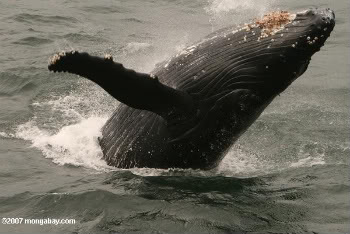Current Marine Protected Areas (MPAs) are too small to adequately serve whales and dolphins according to the Whale and Dolphin Conservation Society (WDCS). The international organization is calling for a global network of MPAs to save the ocean’s most beloved inhabitants.
“A worldwide effort must be made urgently to identify and define whale and dolphin critical habitats and hot spots,” said WDCS Research Fellow, Erich Hoyt. “Then we need to map this information with other species and data to create networks of Marine Protected Areas (MPAs) in national waters and on the high seas. It is like creating a sort of worldwide web for whales and dolphins but connecting not
just the animals, but the special places where they live, and the people there too.”
 Humpback whale breaching in Alaska. Photo by: Rhett A. Butler. |
Whales migrate thousands of miles annually. In fact, the humpback whale holds the world record for the longest migration. Dolphins are wide-ranging and will follow food sources. According to WDCS, 40 percent of the 300 existing MPAs for marine mammals are too small to offer any protection to whales and dolphins.
“Probably less than 1 percent of the world’s marine mammal critical habitat has been identified much less protected,” added Hoyt. “We have discussed strategies for cost-effective measures to attack this huge workload with surveys and other studies. Clearly the emphasis will need to be on rare and endangered species, but we also need to protect healthy populations so that they don’t join the endangered ranks.”
WDCS made the statement last week at the first international conference on marine mammal protected areas held on the island of Maui Hawaii. The conference included over 200 marine mammal scientists, MPA managers and other experts from 40 countries.
Related articles
Supreme Court lifts ban on sonar testing, whales lose
(11/12/2008) A Supreme Court decision will allow the Navy to continue its of sonar in training exercises off the coast of California, a defeat for environmental groups who say sonar is harmful to whales, reports the Associated Press.
The long-ignored ocean emergency and what can be done to address it
(08/18/2008) This year has been full of bad news regarding marine ecosystems: one-third of coral species threatened with extinction, dead-zones spread to 415 sites, half of U.S. reefs in fair or bad condition, increase in ocean acidification, tuna and shark populations collapsing, and only four percent of ocean considered pristine. Jeremy Jackson, director of the Scripps Center for Marine Biodiversity and Conservation at the University of California, San Diego, synthesizes such reports and others into a new paper, published in the journal Proceedings of the Naional Academy of Sciences, that boldly lays out the scope of the oceanic emergency and what urgently needs to be done.
Gray whale populations a fraction of historic level
(09/10/2007) The current population of gray whales is one-third to one-fifth of the number found in the Pacific before industrial whaling began in the 19th century, reports a new study based on genetic analysis.














